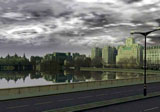 LONDON, U.K. Imagine yourself as a
professional bank robber, leading police on a high-speed chase through the foggy streets
of London. Or, you could be on the other side, playing the cops chasing the bank robber.
The people around you and the scenery are so real, you feel as if you're in a movie.
LONDON, U.K. Imagine yourself as a
professional bank robber, leading police on a high-speed chase through the foggy streets
of London. Or, you could be on the other side, playing the cops chasing the bank robber.
The people around you and the scenery are so real, you feel as if you're in a movie.
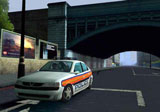 This is what
computer gaming fans can expect to see this Christmas in The Getaway from Sony Computer
Entertainment Europe (SCEE). Taking advantage of the graphics power of the Playstation 2
combined with live actors, motion-capture technology, and unique 3D scanning and morphing
systems, SCEE developers have created perhaps the most realistic game to date. The more
than 100 life-like characters and elaborate scenery would have been impossible to create
in a timely manner without the help of new gaming technologies.
This is what
computer gaming fans can expect to see this Christmas in The Getaway from Sony Computer
Entertainment Europe (SCEE). Taking advantage of the graphics power of the Playstation 2
combined with live actors, motion-capture technology, and unique 3D scanning and morphing
systems, SCEE developers have created perhaps the most realistic game to date. The more
than 100 life-like characters and elaborate scenery would have been impossible to create
in a timely manner without the help of new gaming technologies.
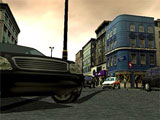 "We'd
still be building the characters well into September 2078 if we had to make them from
scratch," says Dave Smith, character artist. "All the characters in this game
have such a high level of detail. It would take too much time to do this by hand."
"We'd
still be building the characters well into September 2078 if we had to make them from
scratch," says Dave Smith, character artist. "All the characters in this game
have such a high level of detail. It would take too much time to do this by hand."
Unprecedented Realism
 The
characters, from the main actors to pedestrians, drivers and work crews on the street, are
one of the most important aspects of The Getaway. Each character's face and actions appear
as in real life, complete with blinking, breathing and emotional expressions.
The
characters, from the main actors to pedestrians, drivers and work crews on the street, are
one of the most important aspects of The Getaway. Each character's face and actions appear
as in real life, complete with blinking, breathing and emotional expressions.
 The realism
of the characters is matched by the city of London, which could almost be considered a
character itself. The Getaway's production resembles that of Guy Ritchie's popular cult
film Lock, Stock and Two Smoking Barrels. Developers have created "a living,
breathing London" in which players interactively wander around the underbelly of the
city.
The realism
of the characters is matched by the city of London, which could almost be considered a
character itself. The Getaway's production resembles that of Guy Ritchie's popular cult
film Lock, Stock and Two Smoking Barrels. Developers have created "a living,
breathing London" in which players interactively wander around the underbelly of the
city.
 SCEE
recreated more than 31 square miles of London by taking digital photographs of every
building, then modeling them and creating the textures for the game. Within this scenery,
players have the option to be a former professional bank-robber who is pulled back into a
life of crime to save his son from a mob boss, or an embittered police detective who has
an old score to settle.
SCEE
recreated more than 31 square miles of London by taking digital photographs of every
building, then modeling them and creating the textures for the game. Within this scenery,
players have the option to be a former professional bank-robber who is pulled back into a
life of crime to save his son from a mob boss, or an embittered police detective who has
an old score to settle.
 Players will
be able to interactively explore the city on foot or by car, entering and exiting
buildings. They can steal a car and get into high-speed chases with police. If anything is
damaged during the chase, the game's evolving environmental structure will show that area
cordoned off for repair the next time the player passes by.
Players will
be able to interactively explore the city on foot or by car, entering and exiting
buildings. They can steal a car and get into high-speed chases with police. If anything is
damaged during the chase, the game's evolving environmental structure will show that area
cordoned off for repair the next time the player passes by.
Reality of a Theatrical Film
According to Smith, one of the most difficult and time-consuming parts of developing
the game is creating the characters. SCEE wants to create the realism of a theatrical film
within the interactivity of a 3D game.
"You have to have the proper realism to fully project emotions," says Smith.
"We want the player to be able to see the expression on that character's face and to
empathize with him. You can't do this by hand. You could never be that accurate."
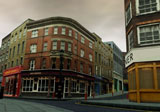 SCEE
developers achieved that accuracy by digitally recreating real actors and their clothing.
Eyetronics' ShapeSnatcher Suite 3D scanning and modeling system allowed SCEE to scan the
actors' faces, and real-time motion capture put the finishing touches on the characters'
movements.
SCEE
developers achieved that accuracy by digitally recreating real actors and their clothing.
Eyetronics' ShapeSnatcher Suite 3D scanning and modeling system allowed SCEE to scan the
actors' faces, and real-time motion capture put the finishing touches on the characters'
movements.
"ShapeSnatcher provides us with a great start to our in-game models," Smith
says. "The scans are quick and accurate -- too accurate, in fact. The detail level in
the scans is far too high for us to run in real time on a Playstation 2. Consequently, the
character artists will use the scan as a template and build a lower-resolution model from
that."
 Where the
developers hit a wall in the process is in sheer volume of work, Smith says. All of the
more than 100 characters have to be modeled, rigged for animation, and set up with SCEE's
proprietary facial animation system. Then they must all have their facial expressions
modified to match the video reference of the live actor being modeled. All of this has to
be done four times for each character to take into account one high-resolution cinematic
model and three in-game levels of detail.
Where the
developers hit a wall in the process is in sheer volume of work, Smith says. All of the
more than 100 characters have to be modeled, rigged for animation, and set up with SCEE's
proprietary facial animation system. Then they must all have their facial expressions
modified to match the video reference of the live actor being modeled. All of this has to
be done four times for each character to take into account one high-resolution cinematic
model and three in-game levels of detail.
"It's a hell of a lot of work, and that's not taking into consideration the
characters' bodies," Smith says.
Same Model, Different Face
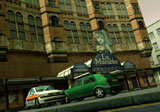 Another
Eyetronics software package, Liquid Faces, enabled Sony to shave weeks off of the
character modeling process, according to Smith. Liquid Faces automatically morphs scanned
faces to Sony's custom template.
Another
Eyetronics software package, Liquid Faces, enabled Sony to shave weeks off of the
character modeling process, according to Smith. Liquid Faces automatically morphs scanned
faces to Sony's custom template.
SCEE developers use a facial skeletal system developed in-house to make the template.
The system uses joints to simulate the actions of muscles in the face, and by combining
the muscle movements, the developers can produce smiles, anger, shock or any other
emotion.
"This presents us with a problem, however," Smith says. "Everyone's face
has different proportions, and we need the simulated muscles to line up under the skin in
the correct positions, or else very strange things happen."
That's where Liquid Faces comes in. Not only does it change the shape of the
character's skin, it aligns the joints into their correct positions to match the scanned
actor's face to the template.
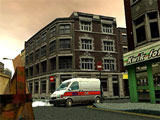 "We
have a single face template model, which has the required level of detail, facial skeletal
system, and all the basic expressions and speech shapes ready to use," Smith says.
"Liquid Faces takes the raw scan data and this template and morphs the low-resolution
models to match the high-resolution scan. Then, viola, one in-game character head. We just
add hair and tweak the animation to match the actor's and it's ready to go."
"We
have a single face template model, which has the required level of detail, facial skeletal
system, and all the basic expressions and speech shapes ready to use," Smith says.
"Liquid Faces takes the raw scan data and this template and morphs the low-resolution
models to match the high-resolution scan. Then, viola, one in-game character head. We just
add hair and tweak the animation to match the actor's and it's ready to go."
The software has allowed SCEE developers to go from initial scans of the characters to
a completed model in a day and a half. Without Liquid Faces, it would take two weeks or
more to model them from scratch, Smith says.
Character files are then transferred to Alias|Wavefront's Maya 3D animation software
for final rendering. Actors' motions are captured with an Ascension motion tracker and
brought into Kaydara Filmbox, a software program that integrates the motion data with the
3D characters for real-time display.
An Immersive Experience
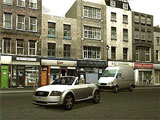 The
result of SCEE's process are characters and scenes so real that the player is absorbed
into the gaming experience, according to Smith.
The
result of SCEE's process are characters and scenes so real that the player is absorbed
into the gaming experience, according to Smith.
"This project would have been a game without characters if it wasn't for the
ShapeSnatcher Suite," he says. "Liquid Faces then allows us to have a consistent
pipeline for our character head generation, which is so important when dealing with the
amount of work required for a game of this size."
The mix of Playstation 2 hardware power, real-time 3D graphics, and 3D scanning and
motion capture has enabled Sony Computer Entertainment Europe to create a game unlike
anything that has come before it. Once players boot it up on the Playstation 2, however,
they aren't likely to care too much about the technology that makes The Getaway possible.
They'll be too immersed in the streets, characters and action of gritty, East End London.
